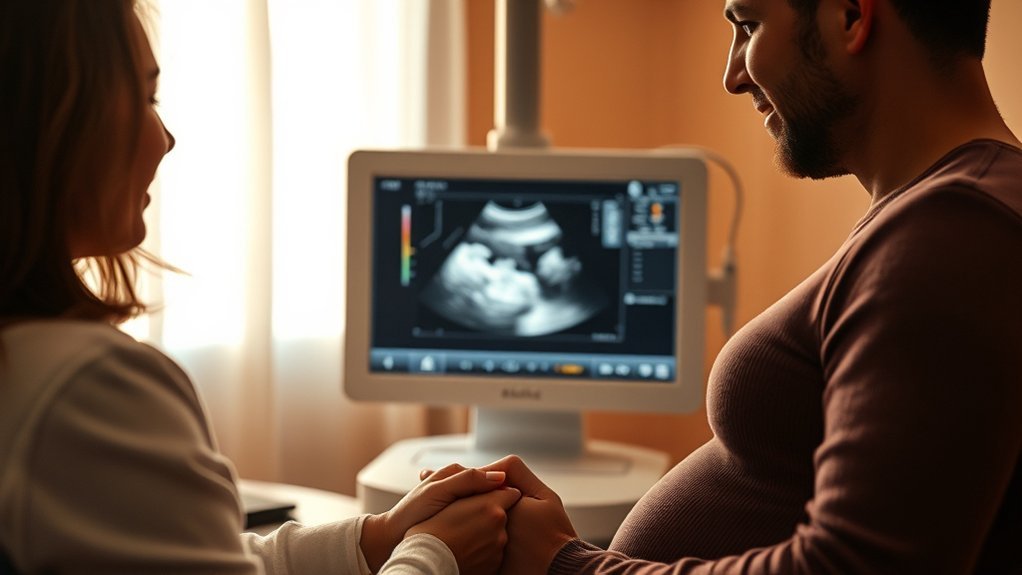An anatomy scan is a significant ultrasound that occurs between 18 and 22 weeks of your pregnancy. It provides essential insights into your baby’s growth and development while evaluating organ function. This scan can reveal important information about potential health concerns, helping you prepare for the months ahead. Understanding the results will be vital, as it not only informs you but also deepens the connection with your baby. What should you expect during this pivotal moment?
What Is an Anatomy Scan?

An anatomy scan, also known as a mid-pregnancy ultrasound, is a detailed imaging procedure typically performed between 18 and 22 weeks of gestation. This scan assesses your baby’s development and checks for any physical abnormalities.
During the procedure, a technician applies gel on your abdomen and uses a transducer to capture images of your baby. You’ll see detailed views of the heart, brain, spine, limbs, and organs. The scan also measures the baby’s growth, including head circumference and limb length.
Additionally, you’ll get a chance to learn your baby’s sex if you choose. It’s vital for identifying potential health concerns early, allowing for timely intervention if necessary. Overall, it provides essential information about your baby’s well-being.
When Is the Anatomy Scan Performed?

The anatomy scan is typically performed between 18 and 22 weeks of pregnancy.
This timing allows for ideal visualization of your baby’s development and anatomy.
It’s an essential part of prenatal care that helps guarantee everything is on track.
Timing of the Scan
Typically, healthcare providers schedule the anatomy scan between 18 and 20 weeks of pregnancy. This timing allows for ideal visualization of your baby’s developing organs and structures.
It’s essential to understand why this window is important:
- Developmental Accuracy: Guarantees accurate assessment of organ development.
- Diagnostic Opportunity: Identifies potential abnormalities early on.
- Bonding Experience: Offers a chance to see your baby via ultrasound.
- Planning Ahead: Provides critical information for birth planning and parental preparation.
Typical Week Range
Between 18 and 20 weeks of pregnancy, most parents can expect to have the anatomy scan performed. This ultrasound plays an essential role in evaluating your baby’s development and health.
During this period, the fetus is typically large enough for technicians to assess key structures, including the brain, heart, spine, and limbs. The scan also helps identify the placenta’s position and checks for any potential abnormalities.
Scheduling the anatomy scan within this window guarantees ideal visibility and reduces the likelihood of needing a follow-up exam. If you haven’t received your appointment yet, consider discussing it with your healthcare provider during a routine visit.
This scan provides valuable information, allowing you to prepare for your baby’s arrival with confidence.
What to Expect During the Ultrasound

During the anatomy scan, you’ll understand the ultrasound’s purpose in evaluating your baby’s development and health.
The procedure typically lasts about 30 minutes, during which a technician will use a transducer to capture images.
Be sure to bring any necessary paperwork and a full bladder for ideal results.
Purpose of the Ultrasound
An anatomy scan, also known as a mid-pregnancy ultrasound, serves multiple essential purposes in monitoring your baby’s development.
This detailed imaging provides vital insights, ensuring both you and your healthcare team can make informed decisions.
- Assess fetal growth: It measures your baby’s size and compares it to gestational age.
- Check organ development: It evaluates organs, including the heart and brain, for proper formation.
- Identify potential issues: It screens for congenital abnormalities that may require further attention.
- Determine gender: If you wish to know, the scan can reveal your baby’s sex.
Understanding these purposes will help you appreciate the importance of the anatomy scan in your pregnancy journey.
Procedure and Duration
While preparing for your anatomy scan, you’ll find the process straightforward and efficient. The ultrasound typically lasts between 30 to 60 minutes.
You’ll lie on an exam table, exposing your abdomen for the technician to apply a conductive gel. This gel helps the ultrasound wand, or transducer, glide smoothly over your skin. The technician will move the wand to capture images of your baby’s organs, spine, and limbs. They might ask you to adjust positions to get better views.
During the scan, you’ll likely hear the heartbeat and see your baby moving. After the procedure, the technician may provide a few preliminary findings, but a detailed report will follow from your healthcare provider.
What to Bring
Before heading to your anatomy scan, it’s essential to bring a few key items to secure a smooth experience.
Being prepared can help reduce stress and guarantee that you focus on the exciting aspects of the ultrasound.
- Insurance Information: Have your insurance card handy to avoid any billing issues.
- Photo ID: Bring a valid identification to verify your identity at the facility.
- Comfortable Clothing: Wear loose-fitting clothes for easy access during the scan.
- Support Person: Consider bringing a partner or friend for emotional support and to share in the experience.
Having these items ready will make the process more efficient and enjoyable as you await those precious first images of your baby.
Understanding the Results of the Anatomy Scan
How do you interpret the results of your anatomy scan? First, review the ultrasound images and measurements your technician provides. These will show your baby’s growth and development, including organ formation and structural integrity.
Pay attention to any notes regarding abnormalities or concerns, as these may require follow-up testing. Your healthcare provider will explain what each finding means and how it relates to your pregnancy.
Be sure to note any abnormalities mentioned, as they may necessitate further testing and clarification from your healthcare provider.
It’s crucial to ask questions if you don’t understand something. Remember, not all findings indicate a problem; many variations are within normal limits.
Finally, trust your healthcare team to guide you through any necessary steps based on your results, ensuring you receive the appropriate care and support moving forward.
Common Measurements and Assessments
During the anatomy scan, your healthcare provider will typically assess several key measurements and parameters to evaluate your baby’s development.
These measurements help guarantee your baby is growing appropriately and identify any potential concerns.
- Crown-rump length: Measures your baby’s length from head to bottom.
- Biparietal diameter: Assesses the width of your baby’s head.
- Abdominal circumference: Evaluates the growth of your baby’s abdomen.
- Femur length: Measures the length of your baby’s thigh bone.
These assessments provide vital information about your baby’s growth patterns and overall health.
Understanding these measurements can help you feel more informed and engaged in your baby’s development during this critical stage.
Identifying Potential Health Concerns
As your healthcare provider conducts the anatomy scan, they’ll be on the lookout for any potential health concerns that could affect your baby’s development.
This scan typically occurs between 18 and 22 weeks of pregnancy and focuses on evaluating key structures, including the brain, heart, spine, and organs. They’ll assess the size and shape of these structures for any abnormalities.
Your provider will also check for conditions like spina bifida or congenital heart defects, which can greatly impact your baby’s health. If they identify any concerns, they may recommend further testing or specialist consultations.
Early detection allows for better management options, ensuring you and your baby receive the necessary care throughout the pregnancy and beyond.
Emotional and Practical Preparation
While preparing for the anatomy scan, it’s essential to address both emotional and practical aspects to guarantee a smoother experience. Here are key points to reflect on:
- Educate Yourself: Understand the purpose of the scan and what to expect during the appointment.
- Manage Expectations: Recognize that not all findings are alarming; some may require follow-up.
- Prepare Questions: Write down any questions you have for your healthcare provider to clarify concerns.
- Bring Support: Having a partner or friend with you can help alleviate anxiety and provide comfort.
Building a Bond With Your Baby Through the Scan
The anatomy scan offers a unique opportunity to connect with your baby before birth. During this detailed ultrasound, you can see your baby’s developing features and movements, fostering a deeper emotional bond.
As you watch your baby’s heart beating and limbs moving, it becomes easier to imagine their personality and future.
Encourage your partner to join you, sharing the experience together strengthens your connection. You might even bring along a small item, like a photo or a keepsake, to personalize the moment.
Ask your technician questions about the images, enhancing your understanding of your baby’s growth. This informed engagement not only reassures you but also deepens your attachment, making the experience memorable and meaningful.
Frequently Asked Questions
Can I Bring Someone With Me to the Anatomy Scan?
Yes, you can bring someone with you to the anatomy scan. Most facilities encourage support, so don’t hesitate to invite a partner, family member, or friend to share in this exciting experience with you.
Will I Receive a Printed Photo From the Scan?
Yes, you’ll likely receive a printed photo from the scan. However, policies vary by facility, so it’s best to ask your technician beforehand to guarantee you get a copy of the images.
Can the Anatomy Scan Determine the Baby’s Gender?
Yes, the anatomy scan can often reveal your baby’s gender. It’s like unwrapping a present—anticipation builds as the technician checks the developing features, providing you with exciting insights into your little one’s world.
What if I Have a History of Pregnancy Complications?
If you have a history of pregnancy complications, it’s essential to discuss this with your healthcare provider. They’ll tailor your care plan and may recommend additional monitoring or tests to guarantee a healthy pregnancy.
How Long Does the Anatomy Scan Typically Take?
The anatomy scan typically takes about 30 to 60 minutes. During this time, your healthcare provider will examine your baby’s organs and structures, ensuring everything’s developing as it should. You may also get to see images.
Conclusion
The anatomy scan is a vital milestone in your pregnancy journey, providing essential insights into your baby’s health and development. For instance, a couple named Sarah and John discovered during their scan that they were expecting twins, a surprise that deepened their emotional bond and prompted them to prepare for a different parenting experience. By understanding what to expect and how to interpret the results, you can navigate this exciting phase with confidence and joy.
